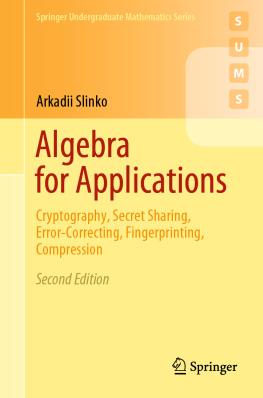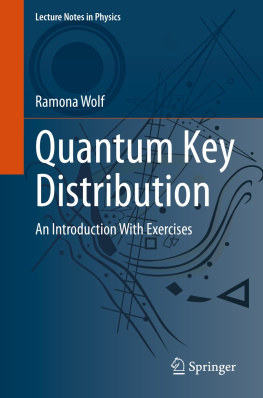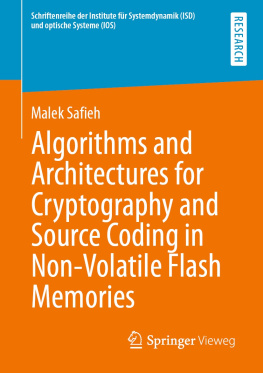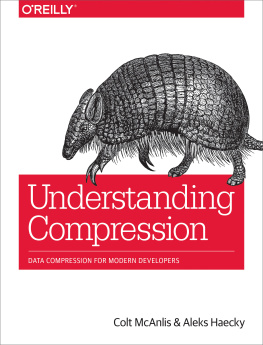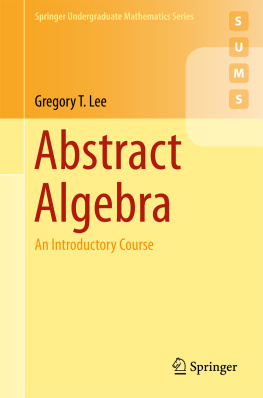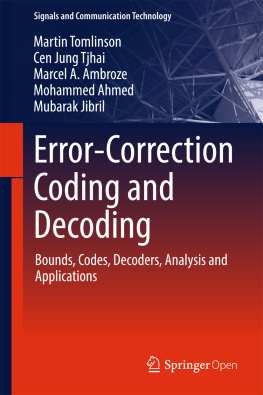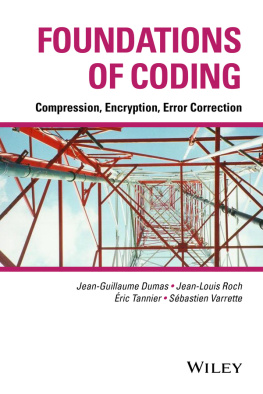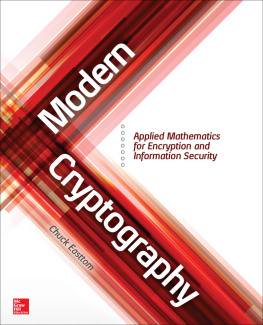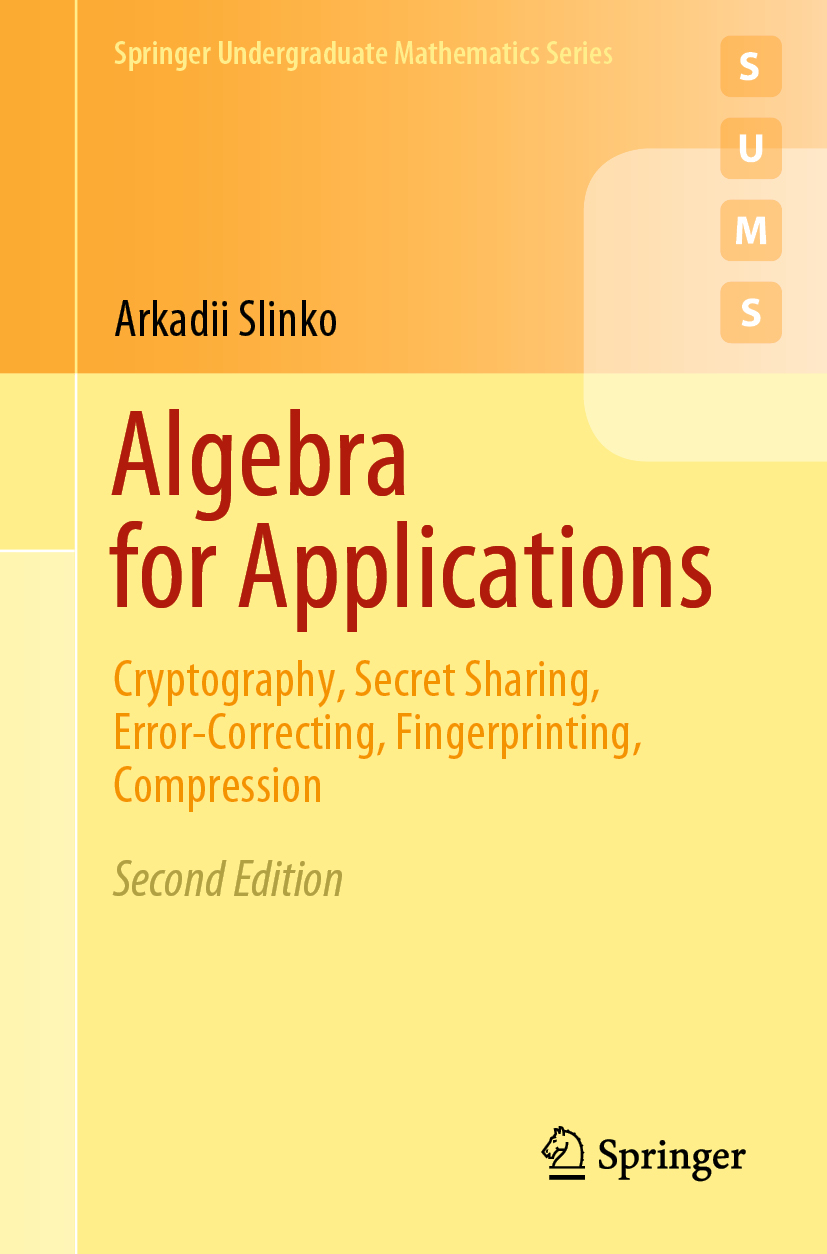Springer Undergraduate Mathematics Series
Advisory Editors
M. A. J. Chaplain
St. Andrews, UK
Angus Macintyre
Edinburgh, UK
Simon Scott
London, UK
Nicole Snashall
Leicester, UK
Endre Sli
Oxford, UK
Michael R. Tehranchi
Cambridge, UK
John F. Toland
Bath, UK
The Springer Undergraduate Mathematics Series (SUMS) is a series designed for undergraduates in mathematics and the sciences worldwide. From core foundational material to final year topics, SUMS books take a fresh and modern approach. Textual explanations are supported by a wealth of examples, problems and fully-worked solutions, with particular attention paid to universal areas of difficulty. These practical and concise texts are designed for a one- or two-semester course but the self-study approach makes them ideal for independent use.
More information about this series at http://www.springer.com/series/3423
Arkadii Slinko
Department of Mathematics, The University of Auckland, Auckland, New Zealand
ISSN 1615-2085 e-ISSN 2197-4144
Springer Undergraduate Mathematics Series
ISBN 978-3-030-44073-2 e-ISBN 978-3-030-44074-9
https://doi.org/10.1007/978-3-030-44074-9
Mathematics Subject Classication (2010): 11A05 11A07 11T71 11Y05 11Y11 68P25 68P30
Springer Nature Switzerland AG 2020
This work is subject to copyright. All rights are reserved by the Publisher, whether the whole or part of the material is concerned, specifically the rights of translation, reprinting, reuse of illustrations, recitation, broadcasting, reproduction on microfilms or in any other physical way, and transmission or information storage and retrieval, electronic adaptation, computer software, or by similar or dissimilar methodology now known or hereafter developed.
The use of general descriptive names, registered names, trademarks, service marks, etc. in this publication does not imply, even in the absence of a specific statement, that such names are exempt from the relevant protective laws and regulations and therefore free for general use.
The publisher, the authors and the editors are safe to assume that the advice and information in this book are believed to be true and accurate at the date of publication. Neither the publisher nor the authors or the editors give a warranty, expressed or implied, with respect to the material contained herein or for any errors or omissions that may have been made. The publisher remains neutral with regard to jurisdictional claims in published maps and institutional affiliations.
This Springer imprint is published by the registered company Springer Nature Switzerland AG
The registered company address is: Gewerbestrasse 11, 6330 Cham, Switzerland
Preface to the Second Edition
In our work, we are always between Scylla and Charybdis; we may fail to abstract enough, and miss important physics, or we may abstract too much and end up with fictitious objects in our models turning into real monsters that devour us.
MurrayGell-Mann (Nobel Prize in Physics in 1969)
My goals for this edition remain the same. I would like this book to be a basis for a one-semester undergraduate course in applied algebra. I want it to be mathematically rigorous and self-contained, and at the same time to provide a glimpse into the exciting world of applications. The challenge for such a course is to avoid getting overexcited about proving theorems and, on the other hand, not to get bogged down with technical details of the applications. This is a delicate balance, and it is up to the reader to decide how well I managed to steer the exposition between these Scylla and Charybdis.
Apart from correcting misprints and improving the order of exercises I added several small but significant sections that provide links between chapters and make the whole construction of the course more connected. The most notable additions are:
The chapter on secret sharing (Chap. ). By using secret sharing we show how a cryptosystem like RSA can be used by an organisation to share the decryption key between members of that organisation.
The chapter on polynomials (Chap..
The chapter on compression of information (Chap..
I also added a number of exercises. Since in the first edition of this book all exercises had solutions (and they still have), I decided to add new exercises (with a few exceptions) without solutions. Those without solutions are marked with a small circle. I also added an index to the book.
Enjoy the book!
Arkadii Slinko
Auckland, New Zealand
February 2020
Preface to the First Edition
The aim of a Lecturer should be, not to gratify his vanity by a shew of originality; but to explain, to arrange, and to digest with clearness, what is already known in the science
George Pryme (17811868)
This book originated from my lecture notes for the one-semester course which I have given many times in The University of Auckland since 1998. The goal of this book is to show the incredible power of algebra and number theory in the real world. It does not advance far in theoretical algebra, theoretical number theory or combinatorics. Instead, we concentrate on concrete objects like groups of points on elliptic curves, polynomial rings and finite fields, study their elementary properties and show their exceptional applicability to various problems in information handling. Among the applications are cryptography, secret sharing, error-correcting, fingerprinting and compression of information.
Some chapters of this bookand especially number-theoretic and cryptographic onesuse GAP for illustrations of the main ideas. GAP is a system for computational discrete algebra, which provides a programming language, a library of thousands of functions implementing algebraic algorithms, written in the GAP language, as well as large data libraries of algebraic objects.
If you are using this book for self-study, then, studying a certain topic, familiarise yourself with the corresponding section of Appendix A, where you will find detailed instructions how to use GAP for this particular topic. As GAP will be useful for most topics, it is not a good idea to skip it completely.
I owe a lot to Robin Christian who in 2006 helped me to introduce GAP to my course and proofread the lecture notes. The introduction of GAP has been the biggest single improvement to this course. The initial version of the GAP notes, which have now been developed into Appendix A, was written by Robin. Stefan Kohl, with the assistance of Eamonn OBrien, kindly provided us with two programs for GAP that allowed us to calculate in groups of points on elliptic curves. I am grateful to Paul Hafner, Primo Potonic, Jamie Sneddon and especially to Steven Galbraith who in various years were members of the teaching team for this course and suggested valuable improvements or contributed exercises.

